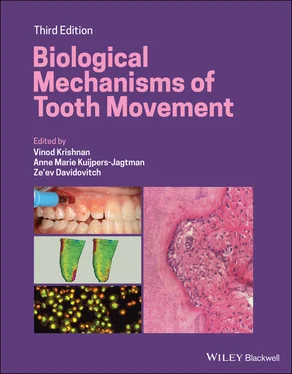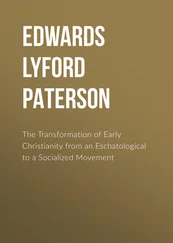Vinod Krishnan Ze’ev Davidovitch Editors
Preface to the Third Edition
Oral health, as defined by the FDI World Dental Federation, is multifaceted and includes the ability to speak, smile, smell, taste, touch, chew, swallow, and convey a range of emotions through facial expressions with confidence and without pain, discomfort, or disease of the craniofacial complex. Oral health has a close relationship with the general health of an individual and dental treatment contributes to the overall wellbeing of the individual, which is a well‐established fact that remains undiminished. The definition from the FDI implicates that malocclusion is not only an aesthetic problem, and states that orthodontic treatment can prevent and intercept further oral diseases and improve quality of life. To effect this, and to reach the stated goal together with our patients, we need to have a broad knowledge ranging from basic science to psychology, or stated in another way, from molecule to man.
Orthodontic tooth movement is the outcome of subjecting teeth to a wide variety of mechanical forces, for long periods of time. This movement is totally dependent upon stimulation and activity of cells near the affected dental roots. Investigations of these cellular responses focus on molecular events on the nuclear, cytoplasmic, and plasma membrane levels. We are very pleased to discover that our initial effort to organize all research related to tooth movement ‘under one roof’ and the subsequent second edition of Biological Mechanisms of Tooth Movement has made its mark among researchers, academicians, residents, and clinicians, equally. It stimulated basic science research in orthodontics, leading to the creation of a strong scientific foundation for the specialty. A sizeable body of new information related to the biology of orthodontic tooth movement has emerged since the publication of the second edition of this book by Wiley‐Blackwell in 2015. Since then, reports on studies about the molecular biology of bone metabolism, root resorption, and relapse of orthodontic treatment outcomes have appeared in orthodontic literature. With Professor Anne Marie Kuijpers‐Jagtman joining the team, who has contributed extensively to tooth movement research and its clinical translation, we are sure that the third edition will be a ‘reading and learning treat’ to all those who embrace it.
We have made the utmost effort updating the contents of this third edition and organizing it into specific areas, with the aim of highlighting the recent findings emanating from basic research, and bring them to the attention of clinicians specializing in moving teeth to new positions, effectively and comfortably. This edition presents four new chapters (tissue reactions, periodontal microbiology, surgically assisted tooth movement, as well as micro‐osteo perforations) and extensive revision of existing ones, especially the third chapter on mechanisms of tooth movement with orthodontic force application.
We would like to thank all our contributors, who are experts in their research area and have demonstrated dedication to this project. We would also like to express our sincere appreciation to the book reviewers, who analyzed critically the first and second editions of the book, which helped us to improve this edition. We express our gratitude to our publisher, John Wiley & Sons, especially Loan Nguyen, Tanya McMullin, Susan Engelken, Jayadivya Saiprasad, Bhavya Boopathi and to our copy‐editor Jane Grisdale who helped us complete the project successfully. We would also like to thank the supporting staff who worked hard to facilitate this publication.
The third edition of the book is aimed at the same audience as the first and second edition – clinicians, academicians, and researchers in the field of orthodontics and allied specialties such as periodontists, bone biologists, and also basic science researchers. The book is also indispensable for postgraduates in orthodontics, not only to understand how but also why teeth can be moved. Our main goal is to decipher the minute details of the investigations on cellular responses, focusing on molecular events on the nuclear, cytoplasmic, and plasma membrane levels, and its cross‐interactions leading to tissue level changes. We attempt to provide clinically plausible translational data which lead to practising a better, biologically oriented orthodontic treatment. We really hope that the educated clinicians who follow these developments can collect pieces of the unfolding puzzle, and relate them to individual patients, leading to a ‘biologic‐friendly orthodontics.’
Vinod Krishnan Anne Marie Kuijpers‐Jagtman Ze’ev Davidovitch Editors
PART 1 Evolution of Biological Concepts
CHAPTER 1 Biological Basis of Orthodontic Tooth Movement: A Historical Perspective
Vinod Krishnan and Ze’ev Davidovitch
For millennia, we were unable to understand why teeth can be moved by finger pressure, as advocated by Celsus around the dawn of the Common Era, but it was working. Indeed, our ancestors were keenly aware of malocclusions, and the ability to push teeth around by mechanical force. The modern era in dentistry began in 1728 with the publication of the first comprehensive book on dentistry by Fauchard. He described a procedure of “instant orthodontics,” whereby he aligned ectopically erupted incisors by bending the alveolar bone. A century‐and‐a‐half later, in 1888, Farrar tried to explain why teeth might be moved when subjected to mechanical loads. His explanation was that the teeth move either because the orthodontic forces bend the alveolar bone, or they resorb it. The bone resorption idea of Farrar was proven by Sandstedt in 1901 and 1904, with the publication of the first report on the histology of orthodontic tooth movement. Histology remained the main orthodontic research tool until and beyond the middle of the twentieth century. At that time medical basic research began evolving at an increasing pace, and newly developed research methods were being adapted by investigators in the various fields of dentistry, including orthodontics; Farrar’s assumption that orthodontic forces bend the alveolar bone was proven to be correct, and the race was on to unravel the mystery of the biology of tooth movement. During the second half of the twentieth century, tissues and cells were challenged and studied in vitro and in vivo following exposure to mechanical loads. The main fields of research that have been plowed by these investigations include histochemistry, immunohistochemistry, immunology, cellular biology, molecular biology, and molecular genetics. From this broad research effort it has been concluded that teeth can be moved because cells around their roots are enticed by the mechanical force to remodel the tissues around them. This conclusion has opened the door for quests aimed at discovering means to recruit the involved paradental cells to function in a manner that would result in increased tooth movement velocity. The means tried in these investigations have been pharmaceutical, physical, and surgical. In all these categories, experimental outcomes proved that the common denominator, the cell, is indeed very sensitive to most stimuli, physical and chemical. Hence, the way ahead for orthodontic biological researchers is clear. It is a two‐lane highway, consisting of a continuous stream of basic experiments aiming at uncovering additional secrets of tissue and cellular biology, alongside a lane of trials exploring means to improve the quality of orthodontic care. Gazing toward the horizon, these two lanes seem to merge.
Biological research has exposed differences between individuals based on molecular outlines and entities. In people who possess similar facial features and malocclusions, this variability, which should be reflected in the diagnosis, may require the crafting of treatment plans that address the individual molecular peculiarities. These differences may be due to genetic and/or environmental factors and should be addressed by a personalized orthodontic treatment plan, adapted to the biological profile and needs of each individual patient.
Читать дальше












